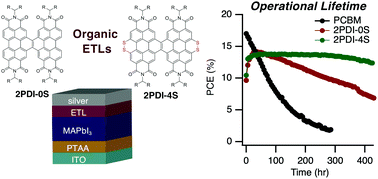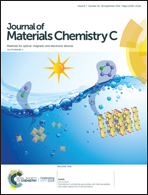Sulfur-fused perylene diimide electron transport layers allow >400 h operational lifetime of methylammonium lead iodide photovoltaics†
Abstract
Hybrid organic inorganic perovskite (HOIP) semiconductors can be used to fabricate thin film solar cells with high solar power conversion efficiencies. The stability of HOIP solar cells depends strongly on the hole and electron transport layers that encapsulate the semiconductor and prevent reactions with metallic electrodes. A series of fused perylene diimide-based compounds with varying degrees of sulfur annulation (2PDI, 2PDI-2S, 2PDI-3S, and 2PDI-4S) were examined as electron transport layers in methyl ammonium lead iodide (MAPbI3) solar cells. The sulfur annulation alters not only the electron affinity of the ETL, but also the chemical interaction with the MAPbI3 layer, resulting in unusually long lifetimes for this class of devices. Devices with 2PDI-4S, which contain two disulfide bridges, as an ETL show little degradation of the power conversion efficiency after 400 hours during solar illumination at the maximum power point, thus exceeding the performance of fullerene ETLs under long time operation.



 Please wait while we load your content...
Please wait while we load your content...